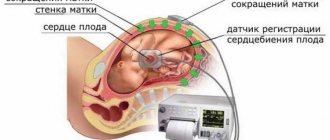For future parents, the most important thing is the health of the child.
Now cases of birth of babies with Down syndrome have become more frequent.
Let's talk about the signs of downism in newborns and the problem in general.
- Newborns with Down syndrome
- How the syndrome develops
- Why does Down syndrome develop in a newborn baby?
- Signs
- Establishing diagnosis
- Rehabilitation of a child with Down syndrome
Newborns with Down syndrome
For many parents, the birth of a baby with Down syndrome is, to say the least, a shock. Others, already knowing about the high probability of having a baby with this diagnosis, decide to have a child. A set of signs and characteristic features is the designation of the term “syndrome”.

It is customary to use this term instead of the usual word “disease”. The characteristic signs of downism become visible to the pediatrician during the first examination of the newborn. But the way children look does not confirm that they have Down syndrome. Additional examinations are needed to confirm the presumptive diagnosis.
Parents of a newborn with Down syndrome should be aware that they will have a difficult time.
Find out more about possible child diseases such as scarlet fever, coxsackie virus, pneumonia, atopic dermatitis, tonsillitis, Edwards syndrome, laryngitis, streptoderma, obstructive bronchitis, adenoids, autism, whooping cough.
These children may have various complications, such as weakened immunity, a tendency to obesity, some mental retardation, poor adaptation to the outside world, low life expectancy, and less often, a tendency to leukemia.
However, many children with Down syndrome lead normal lives and often develop along with normal children. They undergo plastic surgery and become outwardly indistinguishable from others, having lost noticeable signs of Downism.
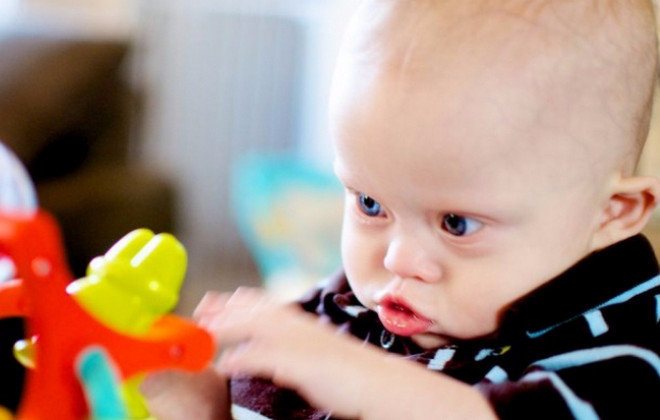
Most experts say that you should not perceive the birth of such a child as a tragedy, but treat him as a normal child.
Important! Currently, babies with Down syndrome appear at a rate of one child per 1,100 newborns.
Children with Down syndrome - who are they? article on speech therapy on the topic
Children with Down syndrome - who are they?
Although the term “Down syndrome” appeared more than a hundred years ago, only in recent decades have Russian doctors, psychologists and teachers begun to interpret it somewhat differently than before.
The word "syndrome" refers to many signs or characteristics. The name "Down" comes from the name of the physician John Langdon Down, who first described the syndrome in 1866.
In 1959, French professor Lejeune proved that Down syndrome is associated with genetic changes.
The human body consists of millions of cells. Typically, each cell contains 46 chromosomes, half of which a person receives from his mother and half from his father. A person with Down syndrome has an extra chromosome on the 21st pair of chromosomes, making a total of 47 chromosomes. The reason why this happens has not yet been clarified. Children with Down syndrome are born to parents from all social classes and ethnic groups, with very different levels of education. Down syndrome cannot be prevented and cannot be cured.
According to statistics, one baby out of 700-800 is born with Down syndrome, and the presence of such people in our lives is not such a rarity, so society should have a correct understanding of their characteristics and accept them as living among us.
The presence of Down syndrome is usually detected soon after the birth of a child. The corners of the baby's eyes are slightly raised, the face looks somewhat flat, the mouth cavity is slightly smaller than usual, and the tongue is slightly larger. Therefore, the baby can stick it out. The palms are wide, with short fingers and the little finger slightly curved inward. There is mild muscle flaccidity (hypotonia), which disappears as the child gets older. The length and weight of the newborn is less than usual.
The extra chromosome affects the health and development of the baby’s thinking. Therefore, some people with Down syndrome may have serious health problems, while others may have minor ones.
Some diseases are more common in people, for example: congenital heart defects, some of which are serious and require surgical intervention; Defects of hearing and even more often of vision are common; thyroid disease and colds often occur. People with Down syndrome typically have varying degrees of intellectual impairment.
How adapted such a child will become to life depends on a number of factors. The degree to which these factors impact each individual child with Down syndrome may vary, but they all influence the child's development and learning.
Several factors influencing the adaptation to life of children with Down syndrome:
•Intellectual difficulties that are common to almost all individuals with Down syndrome. Sometimes the influence of this factor makes itself felt sufficiently.
•Personality. This is the least studied factor. Hereditary traits and environmental influences determine a fairly wide range of personal characteristics of people with Down syndrome.
•Family dynamics. The support of loved ones and their expectations are extremely important and significant; they sufficiently influence the child’s achievements. Siblings, relationships with parents, family economics - all of this plays a role and affects the development and learning of a child with Down syndrome.
•Teaching methods. When choosing a strategy and tactics for teaching children with Down syndrome, it should be taken into account that they learn best if all sensory channels are involved.
•Impact of medical problems. Many children with Down syndrome have quite serious health problems from the first days of life. Some of these problems can be corrected quite successfully and quickly, while others require long and careful treatment or even surgery.
When organizing correctional and pedagogical assistance for children with Down syndrome, underestimating any of these factors can negatively affect the effectiveness of special assistance and, consequently, the disclosure of the child’s potential. Teaching children with Down syndrome builds on their strengths. Good visual perception and visual learning abilities including the ability to learn and use signs, gestures and visual aids; ability to learn written text and use it; the ability to learn from the example of peers and adults, the desire to copy their behavior; ability to learn from individual curriculum materials and practical classes.
Parents of children with Down syndrome, just like all mothers and fathers, are concerned with the question: what future awaits their children? What do they want for their children?
— Be able to fully communicate both with ordinary people and with people whose capabilities are limited. Have real friends among both.
- Be able to work among ordinary people.
- Be welcome in places where other members of the community frequent and participate in common activities while feeling comfortable and confident.
- Live in a house that matches your desires and material capabilities.
- Be happy.
In order to learn to interact with ordinary people as they should, a child with Down syndrome must receive integrated education and upbringing in regular public preschool and school institutions. Integration into a regular kindergarten and school will give him the opportunity to learn to live and act as is customary in the world around him.
The right of children with Down syndrome, like other children with disabilities, to maximum social adaptation, that is, to attend regular kindergartens and schools, is enshrined in law in Russia.
According to modern research, the degree of retardation of most children with Down syndrome ranges from mild to moderate. The intellectual activity of some children can be called borderline or between low and average, and only a very few children have severely delayed intellectual development. It follows that in children with Down syndrome, mental abilities can fluctuate over a wide range.
Problems with speech development.
Children with Down syndrome have deficiencies in speech development (both in the pronunciation of sounds and in the correctness of grammatical structures).
Speech delays are caused by a combination of factors, some of which are due to problems in speech perception and in the development of cognitive skills. Any delay in the perception and use of speech can lead to delayed intellectual development.
General features of speech retardation
*smaller vocabulary leading to less broad knowledge;
*gaps in mastering grammatical structures;
*the ability to learn new words rather than grammatical rules;
*greater than usual problems in learning and using conventional speech;
*difficulties in understanding tasks.
Additionally, the combination of a smaller mouth cavity and weaker muscles in the mouth and tongue make it physically difficult to pronounce words; and the longer the sentence, the more problems with articulation arise.
For these children, problems with language development often mean that they actually have fewer opportunities to participate in communication. Adults tend to ask them open-ended questions and finish their sentences for them without helping them speak for themselves or giving them enough time to do so. This results in the child receiving:
-less speech experience that would allow him to learn new words of sentence structure;
-less practice that would make his speech more understandable.
Thinking.
The profound underdevelopment of the speech of these children (severe damage to the articulatory apparatus, stuttering) often masks the true state of their thinking and creates the impression of lower cognitive abilities. However, when performing nonverbal tasks (classifying objects, counting operations, etc.), some children with Down syndrome may show the same results as other children. Children with Down syndrome experience significant difficulties in developing the ability to reason and build evidence. Children have a harder time transferring skills and knowledge from one situation to another. Abstract concepts in academic disciplines are inaccessible to understanding. It may also be difficult to solve practical problems that arise. Limited ideas and insufficient inferences underlying mental activity make it impossible for many children with Down syndrome to learn specific school subjects.
Memory.
Characterized by hypomnesia (reduced memory capacity), it takes more time to learn and master new skills, and to learn and remember new material.
Deficiency of auditory short-term memory and processing of auditory information.
Attention.
Instability of active attention, increased fatigue and exhaustion, short period of concentration, children are easily distracted and exhausted.
Imagination.
The image does not appear in the imagination, but is perceived only visually. They are able to correlate parts of a picture and, however, cannot combine them into a whole image.
Behavior.
Characterized mainly by obedience, easy submissiveness, good nature, sometimes affectionateness, and willingness to do what is asked. Children make contact easily. A variety of behavioral disorders may also occur.
Emotions.
In children with Down syndrome, elementary emotions are preserved. Most of them are affectionate and affectionate. Some express positive emotions towards all adults and come into contact with them, some - mainly towards those with whom they constantly communicate. In children, positive emotions are observed more often than negative ones. If they fail, they usually do not get upset. They cannot always correctly evaluate the results of their activities, and the emotion of pleasure usually accompanies the end of a task, which may not be completed correctly. Fear, joy, sadness are available. Typically, emotional reactions in depth do not correspond to the reason that caused them. More often they are not expressed clearly enough, although there are also too strong feelings about an insignificant matter.
Personality.
Personally, these children are more likely to be suggestible and imitative of the actions and actions of other people. Some of these children exhibit epileptoid character traits: egocentrism, excessive neatness. However, most children have positive personal qualities: they are affectionate, friendly, and balanced. Early comprehensive care is a new, rapidly developing area of interdisciplinary knowledge that examines the theoretical and practical foundations of comprehensive care for children in the first months and years of life from groups at medical, genetic and social risk of developmental delay.
Features of the development of a child at an early age, the plasticity of the central nervous system and the ability to compensate for impaired functions determine the importance of early comprehensive assistance, which allows, through targeted intervention, to correct primary impaired mental and motor functions with reversible defects and prevent the occurrence of secondary developmental deviations.
Used Books
- A series of books from the Center for Early Help for Children with Down Syndrome “Downside Up”. P. L. Zhiyanova. “Social adaptation of young children with Down syndrome.”
- Gavrilushkina O.P., Sokolova N.D. Education and training of mentally retarded children of preschool age. Programs for special preschool institutions - M. Education, 1991.
- T.P.Medvedeva.I.A.Panfilova. E..V.Field. Series “Child with Down syndrome and features of its development.” Moscow 2004
How the syndrome develops
In 1959 it was determined that it was a genetic pathology. When first described by John Down in the late 19th century, Down syndrome was considered a mental illness.
Such a description was formed precisely on the basis of certain, more external features of the body and the propensity of these people to various kinds of diseases. The fact that this is a congenital genetic pathology at the chromosome level was proven by French geneticist Jerome Lejeune.
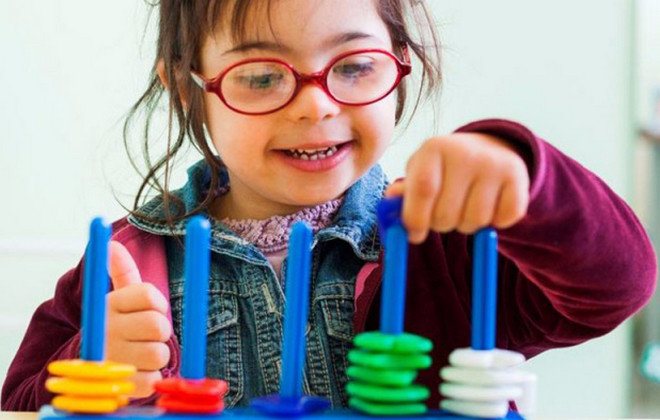
In all cases, the pathology is manifested by the presence of an extra chromosome in the karyotype in addition to the usual 46. And this transformation occurs only with the 21st pair of chromosomes. In 95% of cases, the so-called “trisomy” occurs, when instead of two chromosomes, three are formed in a pair.
It occurs during meiosis due to chromosome nondisjunction in one of the parents. When the resulting gamete with 24 chromosomes fuses with a normal gamete from the other parent, a zygote with 47 chromosomes is produced.
Due to non-disjunction of the mother's gametes, the syndrome occurs in more than 80% of cases, the rest - due to the father. Of the remaining five percent, the majority are so-called “mosaicism.” In this case, a chromosomal abnormality occurs already in the zygote, the disorder affects only some organs, and mosaic Down syndrome develops.
It is milder but more difficult to diagnose.

Forms of Down syndrome
In medicine, there are three forms of the pathology in question:
- Trisomy. Characterized by the presence of three chromosomes instead of two, children with this form of Down syndrome are often born to women with diseases of the reproductive system, stillbirths, and a history of frequent miscarriages.
- Translocation Down syndrome. In this case, a gene or chromosome fragment is transferred to another position. This can happen on the “original” chromosome, but the gene/chromosome fragment can also attach to another chromosome. At the same time, the total number of chromosomes remains unchanged - 46. According to statistics, in 50% of cases of birth of children with Down syndrome, it is the translocation form that is diagnosed.
- Mosaicism. It manifests itself as a combination of cells with a normal and atypical number of chromosomes. Only in 1% of cases of birth of children with Down syndrome is this form of pathology detected. Children with mosaic Down syndrome, as a rule, have high intellectual abilities compared to other forms of pathology.
Why does Down syndrome develop in a newborn baby?
The cause of the anomaly is not fully understood. It has been established that it is not influenced by natural factors, race, physical health and parental habits. There are only hypotheses and some patterns.
It is assumed that the pathology is somehow related to the age of the egg and, accordingly, to the age of the mother. For women over 45 years of age, the likelihood of having a child with Down syndrome is almost 1 in 20, and if the mother is under 25 years old, it is approximately 1 in 1,500.
Did you know? Spaniard Pablo Pineda with Down syndrome has two higher educations, including university. He is 43 years old. He wants to continue learning and teaching.
There is also evidence that the age of the father can influence the birth of such children. If he is over 42 years old, the risk increases. There is an opinion that if one of the parents has relatives with downism, the risk also increases.
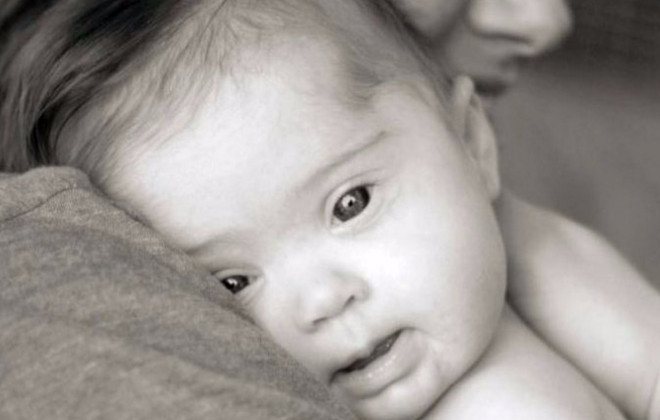
Concomitant pathologies in Down syndrome
The pathology in question is a complex of diseases. Therefore, Down syndrome always has concomitant diseases.
Congenital heart defects
Found in 40% of children with Down syndrome, the appearance of heart defects is associated with abnormalities in the development of the heart muscle, which is caused by the presence of genes on an extra chromosome. It is worth knowing that even a congenital heart defect may not appear immediately; as a rule, this pathology is diagnosed several months after the birth of a baby with Down syndrome.
Most often, against the background of the syndrome in question, non-closure of the interventricular and interatrial septa is diagnosed. Tetralogy of Fallot and patent ductus botallus are much less common. If a congenital heart defect is the cause of circulatory problems, the child will need surgical treatment.
Visual impairment
Occurs in 66% of cases of birth of children with Down syndrome. Possible violations include:
- nystagmus;
- corneal clouding;
- protrusion of the cornea (visually it looks like a cone);
- increased intraocular pressure;
- cataract;
- myopia.
It is quite possible to reduce the risk of developing such pathologies - parents of a child with Down syndrome should undergo a preventive examination with an ophthalmologist at least once a year and limit watching TV and computer activities as much as possible.
Frequent infectious diseases
Children with this pathology have reduced immunity, so they get sick from infectious diseases very often. Particular care should be taken when treating diseases of the trachea, bronchus, tonsils and pharynx. Parents should remember this feature of children with Down syndrome and protect them from contact with obviously sick people, protect them from hypothermia.
Food reflux
This pathology is characterized by the reflux of a portion of food mixed with gastric juice from the stomach into the esophagus. There is only one way to prevent such reflux, thereby alleviating the baby’s condition - to feed him often and in small portions.
Underactive thyroid gland (hypothyroidism)
Diagnosed in 15% of cases, it is characterized by the fact that the thyroid gland produces an insufficient amount of hormones. Metabolic processes are disrupted; little energy accumulates in the body of a person with Down syndrome, which leads to slowness of such people and the appearance of excess weight.
Atresia or duodenal stenosis
Occurs in 8% of cases and is characterized by partial or complete intestinal obstruction, which manifests itself literally in the first days of a child’s life. A sign of the concomitant pathology in question for Down syndrome will be vomiting that begins a few minutes after eating. Only surgical treatment will help solve the problem.
Episyndrome
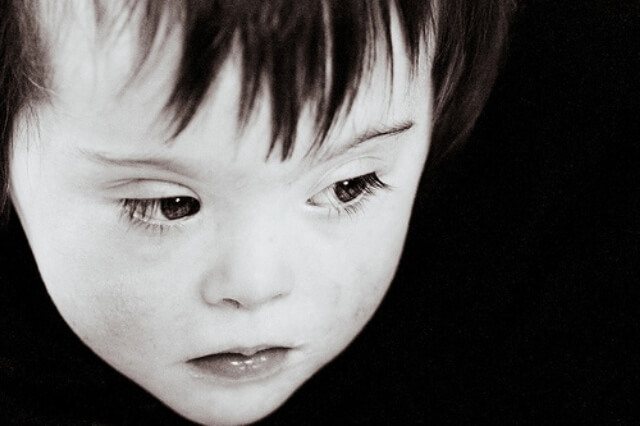
In approximately 8% of cases of children born with the syndrome in question, episyndrome is also diagnosed, which is caused by focal brain damage. As a rule, epileptic seizures occur in people with Down syndrome after severe stress or an infectious disease. Such seizures are manifested by throwing back the head, rolling the eyes, tension/twitching of the lower and upper extremities, hallucinations, fever, rapid heartbeat and severe abdominal pain.
Hearing impairment
This pathology can be caused by abnormalities in the development of the auditory ossicles, which are located in the inner ear. Often, hearing loss in a child with Down syndrome occurs after suffering inflammatory diseases of the hearing organ - parents should not only prevent such diseases, but promptly and fully treat the existing pathology.
Stopping breathing during sleep (apnea)
The airways collapse and the access of air to the lungs is blocked, which is due to the weak tone of the pharynx and the large size of the tongue. To reduce the manifestations of apnea, parents should put the child to sleep in a position on his side, and for very small children, place a cushion from a blanket under the back so that the baby does not roll over on his or her back during sleep.
Congenital leukemia
This is a blood cancer that manifests itself as massive hemorrhages under the skin and mucous membranes, into the internal organs. The child may vomit blood or have blood in the stool. Modern chemotherapy can alleviate the patient’s condition and temporarily relieve severe symptoms.
Please note: despite the fact that the listed concomitant pathologies are quite common in children with Down syndrome, it is not at all necessary that they will occur. But even if some pathologies appear, modern medicine solves these problems.
There is no cure for Down syndrome.
Yes, doctors will closely monitor the child, parents will have to quickly respond to even minor changes in the baby’s health, but the pathology in question will remain forever. Don't despair! Down syndrome is not a death sentence; there are a lot of rehabilitation programs, methods of psychological influence, and new methods are being developed to improve the condition of children with this pathology. The life expectancy of such people is 50 years or more (much depends on concomitant pathologies and the form of the syndrome), they are highly trainable, can master many professions and be socially adapted in society. We recommend reading: Children with Down syndrome - what parents need to know
Tsygankova Yana Aleksandrovna, medical observer, therapist of the highest qualification category
13, total, today
( 193 votes, average: 4.63 out of 5)
Aggressive behavior in children - pathology or behavioral reaction?
Barbituromania: consequences of barbiturate abuse, treatment of addiction
Related Posts
Signs
As a rule, external signs serve as a basis for the assumption of Down syndrome in newborns. Based on them, the pediatrician can make a preliminary diagnosis. Here are the main symptoms in newborns that are immediately noticeable:
- the flatness of the face is clearly expressed, it seems flat when compared with others;
- a noticeable fold on the neck;
- eye shape characteristic of the Mongoloid race - oblique with raised corners;
- the shells of the ears are deformed, have a small lobe, the ear canals are narrower than they should be;
- the skull is shortened, the back of the head is flattened;
- the muscles are flaccid, in decreased tone, but the joints are not moderately mobile;
- legs and arms are shorter than those of other children;
- the fingers are short, which makes the palm appear large;
- small height and weight of the newborn.

If all these signs occur, the doctor, before initially identifying Down syndrome in newborns, pays attention to less noticeable features, such as:
- the baby’s mouth is almost always slightly open due to small jaws;
- the palate of the jaw is in the form of an arch;
- due to the reduced mouth, the tongue appears large, which sticks out due to decreased muscle tone;
- the chin is in proportion smaller than necessary;
- the crooked little finger is bent towards the ring finger;
- the bridge of the nose is wide, flat;
- disproportionately short nose and neck;
- the big toe is located at a greater distance than necessary from the others and a fold forms on the foot under it;
- When examining internal organs, cardiac dysfunction is detected.
Did you know? In the town of Salon-sur-Saone, the skeleton of a child with signs of Downism was discovered. This is the oldest confirmation of such a disease.
Establishing diagnosis
Even if children have all the signs of Down syndrome, this is not one hundred percent evidence of chromosomal pathology.
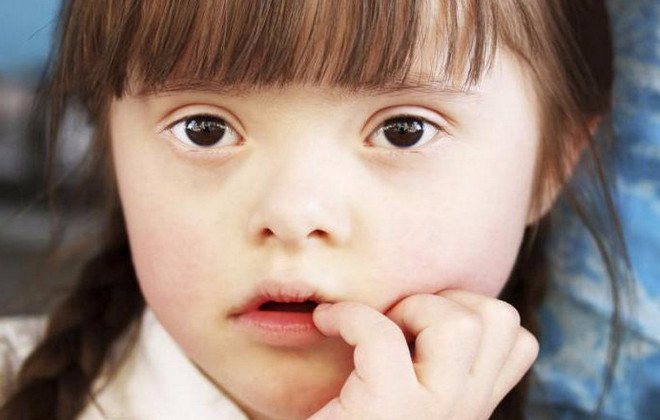
All symptoms may be normal physiology for a child, his peculiarity, or indicate some kind of health problem.
The assumption can be confirmed in only one way - take a blood test for karyotype. Even if it turns out to be positive, do not despair.
You can and should try to adapt the baby to the conditions of the surrounding world. It’s not for nothing that these babies are called sunny. They give a sea of love, responding to your efforts to help.


